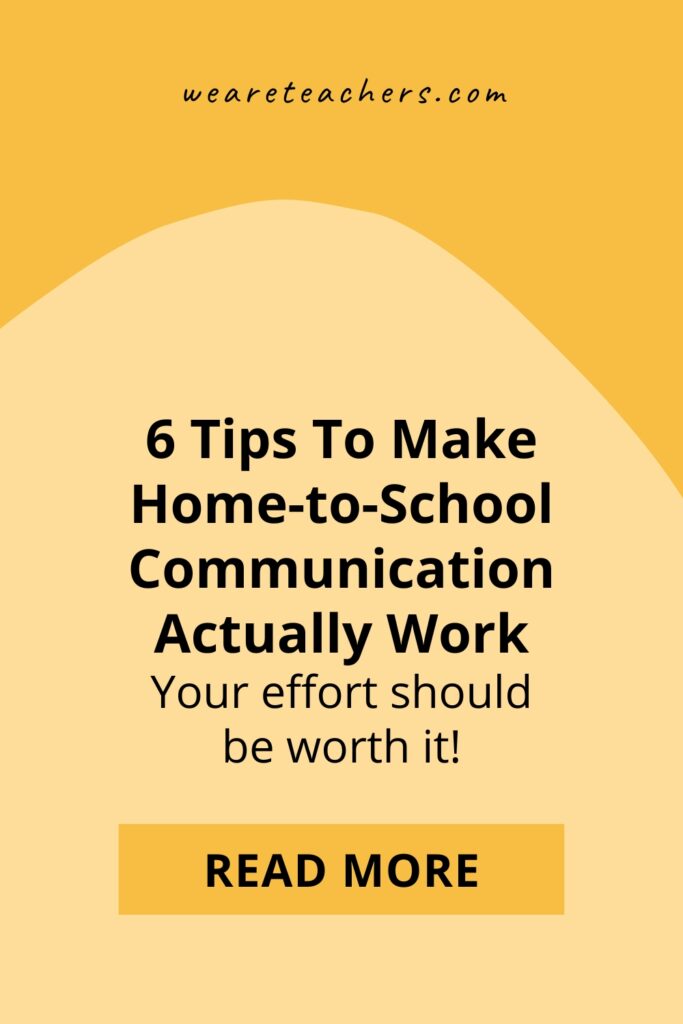Plenty of research suggests that family involvement in kids’ education positively relates to academic achievement, social-emotional growth, engagement, and motivation. Since my kids routinely report they did “nothing” at school each day, I rely heavily on school communication from teachers to reap those involvement benefits.
It takes teachers’ precious time away from a million other to-dos to send updates home—where it’s also busy! How can sharing information about classroom learning be easy for teachers and also cut through the chaos of family life? Here are a few tips from my hectic household to help maximize your home-school communication efforts:
1. Embrace bite-sized updates.
When I was a young teacher, I toiled over a lengthy newsletter every Friday with learning highlights from the week. Now that I know what it’s like to be on the receiving end of classroom updates, my priorities are different. As a parent, getting an overview of upcoming curriculum units or areas of focus is definitely helpful. Occasionally is enough, though. (Ideally, your district has most of this information permanently posted, and you can just direct families to the right place.)
What I really want is to have something to talk about with my kids at dinner. Waiting until the end of the week or month for a summary of classroom activities just doesn’t work as well for us, because my kids’ memories seem to be almost entirely wiped clean every few days. When a teacher sends home a straightforward, specific message saying, “Ask your child about [insert something that happened within the past 24 hours, described in language familiar to my kid],” it’s amazing how much better the resulting conversations go. Bonus points if there’s a photo that I can show my child to probe them for more details.
2. Let parents know what home-school communication to expect.
Routines work for families at home like they work for kids at school. If I know when to expect communication from you, I can get into the habit of looking for that after-school “Ask Me!” prompt or your “Sunday Reminders” email. I’ll wait to bug you with my question until I see if you answer it in your next update too. I can also more easily search for the Pajama Day date or a sign-up link if I need it later.
It’s especially helpful if schools make group decisions about their communication methods. I already have 27 kid-related apps on my phone. There’s the attendance portal, school lunch menus, baseball score-keeping, soccer scheduling, and more, so anything new adds to the overwhelm. When I can learn a home-school communication platform and use it repeatedly, it works better. (Plus, I waste way less time trying to remember my login name and password.)
3. Use paper communication strategically.
Paper communication is on its way out in many places, and probably for good reason. Look at my five kids’ wild hair and their clothes that are mysteriously dirty before breakfast. Now, think about how my kitchen counter must look by the end of the day. Paper notices don’t stand a chance.
The one time paper works for our family is when talking about school learning becomes part of kids’ homework. If you want my kid to tell me about their science experiment or show off the latest multiplication facts they’ve memorized, sending a slip for an adult at home to sign makes it clear that it’s required. (But please, put it on bright paper so it stands out from the sea of white!)
4. Anticipate barriers for families.
Your work is for nothing if families don’t see your home-school communication. One year, my son’s teachers created a beautiful classroom website that they updated frequently. The trouble was, there was no option to receive alerts when they made new posts. I never remembered to look at it. Whether you’re using a private Instagram page, blog, home-school communication app, or something else, make sure that each family can access it. Give them all the tips about turning on notifications so they see your updates.
Before you assume families are ignoring your communication, confirm they actually received it. Earlier this year, when I was flagged for not returning a permission slip, I found out there was a tech glitch related to a new mass-emailing platform the district started using. It had caused me to miss a slew of fourth grade newsletters.
What works for my family may not work for another family in the class. It’s extra important to check in with multi-lingual families about their preferences and needs. Use translation tools if needed and ask for their feedback. If internet access is an issue, maybe paper has to be the way you go sometimes. If you always compose on a computer, but families access information on phones, be sure to preview the mobile view to make sure the formatting is readable.
5. Copy editing is appreciated!
There will always be mistakes—you’re human! But remember, families are trusting you to educate their young writers. Building that trust is hard if your written communication is full of errors, slang, or other things we teach kids to avoid in professional writing. Make sure to proofread your communications before hitting “send” or “post.”
6. Let parents know you’re a real person.
When I was a young teacher, I wasn’t always sure how to connect with parents and caregivers. It was hard to find much common ground, and I wanted them to take me seriously. As a parent, it’s much easier to relate to my kids’ teachers who share tidbits about their own lives. So go ahead and mention in your home-school communication that you went on a great hike last weekend, hosted your high schooler’s track team for a pasta dinner, or dabbed your eyes at your daughter’s dance recital. It’s a small gesture that can have a big impact on your relationships with families. (Also, now those typos don’t bother me as much. You were busy crying over the tiny tutus!)
For more articles like this, be sure to subscribe to our newsletters.


